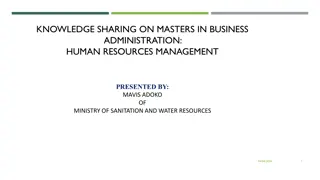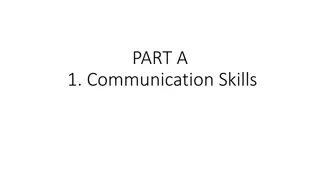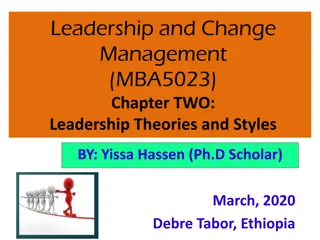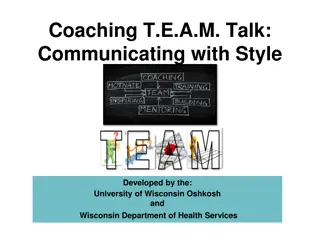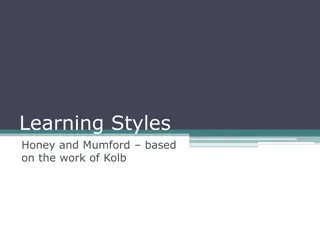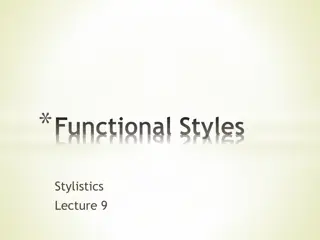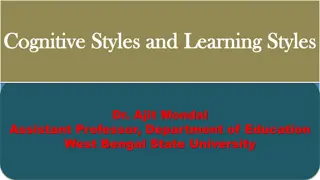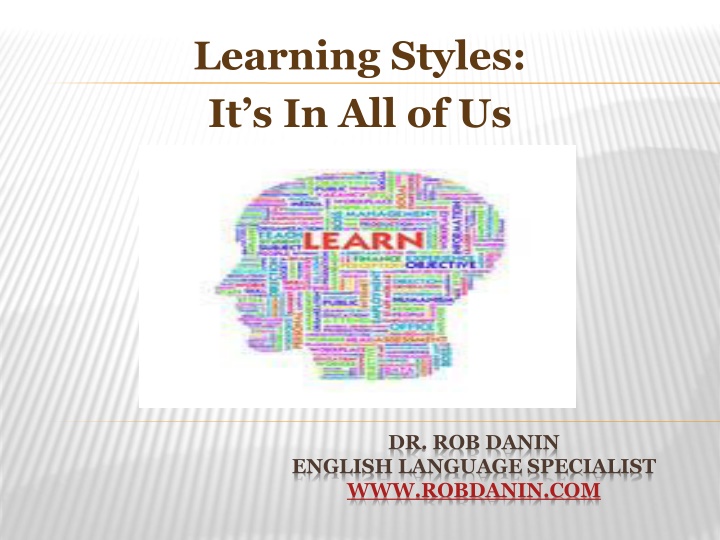
Student Learning Styles and Approaches for Effective Education
Explore the various learning styles such as visual, auditory, and tactile, and understand how teachers can adapt their teaching methods to cater to diverse student preferences. Discover the importance of personalized instruction, cultural considerations, and multiple intelligences theory in fostering effective learning environments.
Download Presentation

Please find below an Image/Link to download the presentation.
The content on the website is provided AS IS for your information and personal use only. It may not be sold, licensed, or shared on other websites without obtaining consent from the author. If you encounter any issues during the download, it is possible that the publisher has removed the file from their server.
You are allowed to download the files provided on this website for personal or commercial use, subject to the condition that they are used lawfully. All files are the property of their respective owners.
The content on the website is provided AS IS for your information and personal use only. It may not be sold, licensed, or shared on other websites without obtaining consent from the author.
E N D
Presentation Transcript
Learning Styles: It s In All of Us DR. ROB DANIN ENGLISH LANGUAGE SPECIALIST WWW.ROBDANIN.COM
By the Numbers Rief (1993) says that students retain: 10% of what they read 20% of what they hear 30% of what they see 50% of what they see and hear 70% of what they say 90% of what they say and do
Student Learning Cognitive visual, auditory, or psychomotor learning Affective a personal approach to learning (socio- emotional) Physiological individual learning preferences (e.g., Quiet deep thought, reflection) Students vary dramatically in the way they process and understand information. These differences, called learning styles , refer to students preferences for some types of learning activities over others. A student s learning style has to do with the way he or she processes information in order to learn and apply it. Students who understand their own styles are likely to be better learners.
Learning Styles Teachers who understand their students learning styles are better able to adapt their teaching methods appropriately. Most people exhibit some combination of learning style or prefer one style to another depending on the type of learning task they are undertaking. Visual learners prefer to study graphs, look at models and pictures, and take notes to review later Auditory learners prefer to listen closely in class, read aloud when studying during lectures in class, or confer with peers in class to confirm information Verbal learners likely to absorb reading materials and lectures easily, prefer written materials over visual materials such as graphs and illustrations Tactile learners learns through moving, doing, touching (hands-on methods), manipulating materials and objects (realia)
Learning Styles: A Quick Review Personalized Instruction: The effort to organize the learning environment to take into account individual student characteristics and needs and to make use of flexible instructional practices. To help students to recognize their cognitive strengths and weaknesses To adapt the learning environment and instruction to learner s needs and interests Cultural differences: Learning occurs in social/cultural environments. Therefore, access to varied instructional resources to ensure multiple perspectives is vital. Gender differences: Cognitively wired to learn differently Can be measured by a variety of assessments (e.g., Learning Styles Inventory )
LEARNING STYLES APPROACHES Multiple Intelligences (MI): Howard Gardner Frames of Mind (1983) Linguistic intelligence: sensitivity to spoken and written language, the ability to learn languages. For example: Logical-mathematical intelligence: capacity to analyze problems logically, carry out mathematical operations, and investigate issues scientifically. For example: Musical intelligence: involves skill in the performance, composition, and appreciation of musical patterns. For example: Bodily-kinesthetic intelligence: potential of using one's whole body or parts of the body to solve problems. For example: Spatial intelligence: potential to recognize and use patterns. For example: Interpersonal intelligence: capacity to understand the intentions, motivations and desires of other people. For example: Intrapersonal intelligence: capacity to understand oneself. For example:
LEARNING STYLES APPROACHES Multiple Intelligences (MI): Other possible intelligences Naturalist intelligence: enables human beings to recognize, categorize and draw upon certain features of the environment. For example: Existential intelligence (spiritual intelligence): concern with 'ultimate issues . For example: Moral intelligence: adoption of any specific moral code regarding personality, individuality, will, character and the realization of human nature. For example: MI Professional Development Considerations Create lessons that cultivate MI in the classroom. Do you have an inclination towards any particular MI attribute(s)? If so, notice whether these influence your instructional approach. The same goes for Learning Styles. If so, in what ways?
Learning Styles: Teaching Methodologies Provide a balance of concrete information (facts, data, and experimental results) and abstracts concepts (principles, theories, and models.). Teaching as a science. Balance materials that emphasize practical problem- solving methods with materials than emphasizes fundamental understanding. Use pictures, graphs, and other visual cues before, during and after the presentation of verbal material. For the auditory learner, paraphrasing is a powerful strategy for making material meaningful. For the tactile learner, role playing is a useful comprehension strategy. Bottom line: Only meaningful information is transferred to long term memory.
Advice for Visual Learners Use visual materials such as pictures, charts, and maps Use color to highlight texts and own notes Take notes or use handouts; look carefully at headings and patterns of topics Brainstorm using illustrations, mind maps and models Use multi-media where possible (computers; mind maps) Study in a quiet place away from visual disturbances Visualize information as a picture Skim-read to get an overview before reading in detail
Advice for Auditory Learners Participate frequently in discussions and debates Make speeches and presentations Use a tape recorder if possible instead of (or as well as) making notes Read text aloud Discuss your ideas verbally Dictate to someone else while they write your ideas down Speak onto an audio-tape and listen to your own ideas played back. Create musical jingles and mnemonics* to aid memory * One example is the Russian word for cow ( , pronounced roughly karova): think and visualize "I ran my car over a cow."
Advice for Tactile Learners Take frequent study breaks Move around to learn new things (e.g., read while you are using an exercise bike; model in clay to learn a new concept) Stand up to work Use bright colors to highlight reading material and turn it into posters or models Skim-read before reading in detail
LEARNING STYLES: CURRICULUM DEVELOPMENT
LEARNING STYLES: MATERIALS DEVELOPMENT HOW TO? Determine the ability level of your students Align tasks and objectives to learning goals Survey student interests/learning styles Interest Inventories, Interview/Conference, respond to Open-Ended Questionnaire What are your student s preferences and motivators? Brain-based research Know YOUR students EXAMPLES: Use instructional materials at varying readiness levels Put text materials on tape Use Study Buddies Meet with small groups to re-teach a concept or skill for struggling learners or to extend learning
LEARNING STYLES: DIFFERENTIATED INSTRUCTION Customized lessons in order to meet students varied learning needs Tiered Activities Develop Personal Agendas for Completion of Work Self Talk- Here s my plan for how to complete this project. Manipulatives (or) Hands on Supports Varying the Length of Time (Pacing) Memorization KWL Reciprocal Teaching Creating dioramas Constructing mathematical models Developing photos Debating Semantic Webbing/Graphic Organizers
UNDERSTANDING YOUR LEARNING STYLE Partner Activity It is unlikely that your style of learning will be the same as everyone else. Take turns with your partner to memorize and share these two groups of letters: aaysa smjptc Now ask each other how you went about the task. aaysa smjptc Did you make the letters into words, and memorize the sounds ay-sir and smidge-ptk ? Did you memorize the visual pattern made by the letters? Did you make a mnemonic, like anarchists annoy your sour aunt or smart mice jump past the cat ? Did you use some other strategy?
UNDERSTANDING YOUR LEARNING STYLE Each of us has our own strategies for such mental tasks. Does this tell you anything about ways of approaching learning? If you read the two groups of letters (starting with the bottom right letter and zig-zagging as you read towards the left) it spells cats pyjamas . aaysa smjptc
UNDERSTANDING YOUR LEARNING STYLE Group Activity Try and spot the pattern in this group of letters: acegijlnprtvxz If you see the pattern, please do not share right away. Every second letter has been omitted until i which is immediately followed by j , then the pattern resumes from there. How did you go about spotting this pattern? We are all likely to have a preference in solving cognitive activities (learning style).
Learning Styles Inventory A great ice-breaker activity
UNDERSTANDING YOUR LEARNING STYLE Learning Style Inventory Take a few minutes to complete and score the learning style inventory you have received. Take another few minutes to reflect on the results of this inventory. Does the results match what you thought was your learning style preference? If not, what do these results mean to you? Will it change your style of learning? Will it have an impact on your teaching style?
LEARNING STYLES: ITS IN ALL OF US I hope that this time together helped you to better understand the concepts related to learning styles your own learning style and how you may utilize it in the future
THANK YOU!! Online Resources: Learning Styles & MI Inventories & Personality Test @ www.robdanin.com

